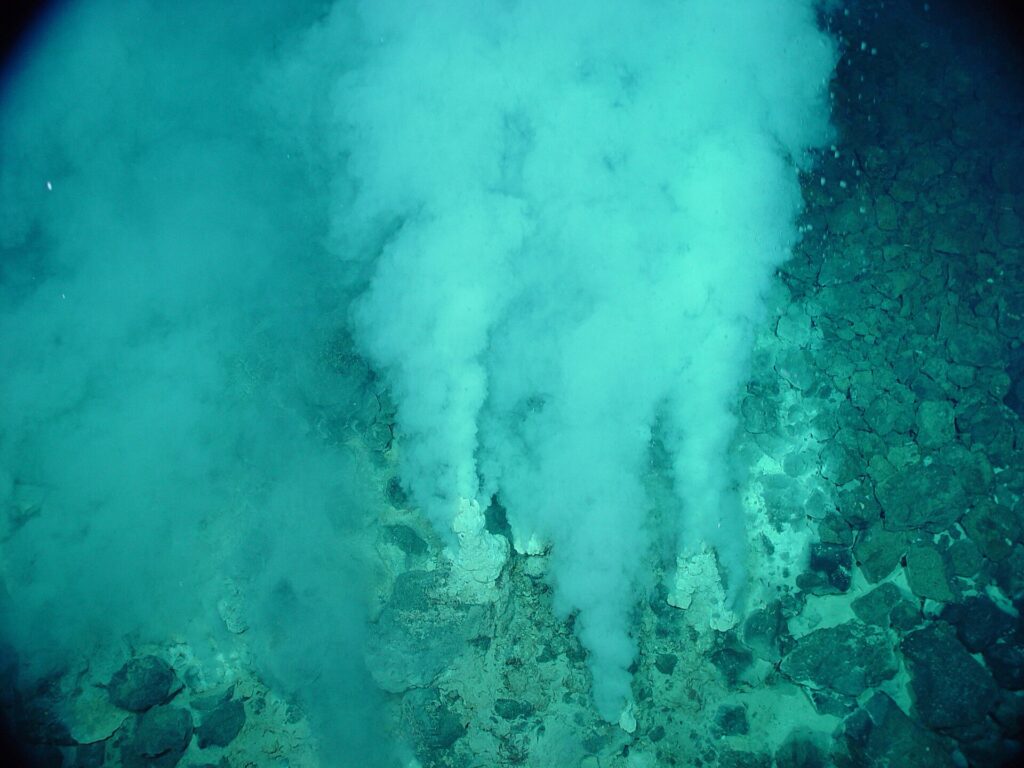
Featured image: White flocculent mats in and around the extremely gassy, high-temperature (>100°C, 212°F) white smokers at Champagne Vent. Copyright: CC BY-SA 4.0 via. wikimedia commons.
Paper: White and green rust chimneys accumulate RNA in a ferruginous chemical garden
Authors: Vanessa Helmbrecht, Maximilian Weingart, Frieder Klein, Dieter Braun, William D. Orsi
When we think of alien worlds, we may evoke an image of vast oceans with tall scattered vertical structures, like columns or towers. By looking at pictures of alkaline hydrothermal vents, you will realize that such alien worlds do not just exist in science fiction movies. Alkaline hydrothermal vents are deep ocean environments widespread on Earth more than 4 billion years ago, in which light globular and spiky chimneys rise from the dark ocean floor. They offer a combination of chemical conditions that may have supported the first forms of life on Earth. However, alkaline hydrothermal vents have been considered inhospitable for the formation of nucleic acids, the information-storage molecules present in all living cells. A new paper from researchers at LMU Munich challenges this assumption by providing critical evidence for the stabilization of nucleic acids in alkaline hydrothermal vents, a discovery that would make these environments the most suitable candidates for the origin of life on Earth.
How life arose on Earth is arguably one of the most intriguing and elusive questions in science. The idea of “warm little ponds” for the origin of life was popularized by Charles Darwin as early as 1871. In its modern form, it posits that terrestrial ponds, rich in essential elements for the formation of life, may have gone through wet and dry cycles in the early Earth. These cycles would have been key to the formation of RNA, a nucleic acid that combines the information storage property of DNA with the capability of accelerating reactions of some proteins. This so-called ‘RNA-world’ hypothesis, which places RNA as the storage molecule present in the first life forms on Earth, is very widely accepted today.
By contrast with the terrestrial ponds proposed by Darwin, alkaline hydrothermal vents have only gained recognition as another plausible environment for the origin of life over the last 40 years or so. They are an authentic science quandary: while they could have provided the most readily available sources of energy for the first cells, as well as porous structures to physically separate them from the exterior, they are incompatible with the RNA-world hypothesis. The reason is simple; RNA has a much more fragile structure than DNA, which is prone to heat degradation. An additional constraint for the origin of life in alkaline hydrothermal vents is that, in a vast ocean, the first nucleic acids were extremely diluted, which represents a ‘concentration problem’ for their incorporation into cells.
Helmbrecht et al. sought to address, in a controlled laboratory setting, whether the chimneys present in alkaline hydrothermal vents could actually offer a solution to the concentration problem. This is the first time that the capacity of the chimneys to accumulate nucleic acids, specifically RNA, was tested. Their setup consisted of 5 glass vials, purged of all oxygen and filled with an iron-rich solution containing yeast RNA, designed to be analogous to ancient seawater. They pumped an alkaline solution through each vial to represent the hydrothermal fluid from underwater vents, and immediately observed the formation of rock chimneys during the first two hours of the reaction.
From observing this chimney growth, Helmbrecht et al. found that white rust is the predominant mineral that forms during the initial phase of vertical chimney growth, and its formation coincides with a rapid transfer of RNA from the iron-rich solution to the chimney. After a few minutes, white rust in the chimney is replaced by green rust, and less RNA accumulates in the chimney. The researchers’ critical discovery was that, when rust chimneys are present, RNA concentrations decrease by an impressive 1000-fold in the solution! The implication, if it could be extrapolated to the oceans of the early Earth, is that green rust chimneys allowed the concentration of RNA – previously floating free in ancient seawater – into alkaline hydrothermal vents.
Helmbrecht et al.’s key finding is not only that RNA can indeed be stabilized and concentrated in chimneys from alkaline hydrothermal vents, but also that the incorporation depends on the stage of chimney growth and the types of rust minerals that compose it. By providing the first experimental evidence of nucleic acid stabilization in rust structures, Helmbrecht et al. confirmed that the RNA-world hypothesis is compatible with the origin of life in alkaline hydrothermal vents. While the controversy over the first environment where life arose on Earth is nowhere close to an end, the mechanism of RNA accumulation confirmed by Helmbrecht et al. gives an upper hand to alkaline hydrothermal vents.
New support for the origin of life in alkaline hydrothermal vents by Daniela Osorio Rodriguez is licensed under a Creative Commons Attribution 4.0 International License.
